Most people will agree that finding a niche is the toughest part of building profitable sites. There are so many options available and you can get stuck in the niche research phase for months and months.
I’ve been doing a ton of niche research myself lately, and in this post I’m going to take you through my process and go over some important things you need to consider.
Let’s find one together! I’ve done no research and planning prior to writing this article. I’m just going to open up some tools and start digging into niches I haven’t analyzed before, explaining what I’m looking for live as I go through them. If you’re looking for niches, awesome. Follow along!
First, let’s talk about goals
Before you get into doing any kind of research, you first have to think about your goal with the site you’re planning to build.
For example, one goal of mine this year is to start a big project. My goal is to build the largest authority site project I’ve ever undertaken.
I’m giving myself up to 5 years to (hopefully) grow it to a 7 figure valuation, and then exit at an appropriate time.
*An appropriate time is usually when scaling plateaus to a degree. For example, scaling content and link building doesn’t move the needle as much as it used to, which happens when you get to larger numbers.
Everybody’s different when it comes to their blogging goals.
Some people might just want to build a site that make a couple hundred dollars per month. Some people might want thousands per month to replace their day job.
Some people are able to go full-time on their projects, while others will only be able to spare 1-2 hours per day.
It’s important to clearly identify your blogging goals early on, so that you can find the appropriate, most suitable niches during your research phase.
Once you’re done that, we can move onto the first step.
The first step of the process
The first step is to get some ideas out. Very basic stuff.
What I like to do is just list out a bunch of topics/niches that I’m interested in.
Here’s what that would look like:
- Running
- Tech
- Kayaking
- Hiking
- Golfing
- Camping
- Travel
- Personal Finance
- Saving money
- Keyboards
- Laptops
- Standing desks
- Work chairs
- Web design
- Graphic Design
- Dogs
- Nice homes
This is very generalized and it doesn’t need to be organized, or even make sense. I’m not thinking too hard, and am just jotting whatever comes to mind. FYI: I stopped after about 30 seconds. I can (and you should too) be able to just jot dozens of ideas in under 5 minutes.
You’ll get more data to get more specific in the later stages of the process. For now, just write whatever pops up in your head. And remember… they should be things you’re at least a little bit interested in.
Next step: Estimating max traffic potential
This is one of the first things I research, and it’s a good way to ensure you meet the goals you set in the beginning.
Basically, we’re calculating the maximum level of traffic we might receive as one of the top sites in that niche. Market size can vary greatly, and you can’t really judge the size of a niche accurately based only on adding up a few big keyword search volumes.
For larger niches, traffic might be in the millions of visitors per month. For smaller ones, it might be capped at less than 100,000.
Knowing this is extremely important. If you’re entering any niche, you want to get a good idea of what a “success” will mean. (ie. What will becoming one of the biggest sites in the niche mean in terms of traffic and revenue?)
How to estimate potential traffic in a niche
Here’s how you do it. Let’s take one of the ideas we jotted down earlier: Hiking.
I’ll start out by Googling some short to medium tail keywords
These are just off the top of my head. For example, I’ll start off my searches with keywords like “hiking tips, how to hike longer, best hiking gear.”
One of the reasons we use short to medium tail keywords is because usually the most authoritative sites rank highly for broader terms like these (i.e. If they’re ranking for “hiking tips” they probably rank for a lot of other keywords related to hiking as well).
Here’s what a Google search brought back.

What I’m looking for here are ONLY sites specifically targeted toward hiking. I’m ignoring all the broad sites about multiple topics like NPS, Outdoor Australia, and Nerd Fitness.
Why?
Because we’re looking to build a hiking site, so we want to analyze other hiking sites.
Next, I’m going to input them into SEMrush one by one
SEMrush is a paid tool, and pretty expensive. It’s not absolutely essential to use SEMrush for this step. It will help you to get more accurate info faster, but you can just skip this part and do manual Google searches instead if you need.
But if you want to try it out, you can sign up for a 14 day free trial here.
I’m going to take one of the sites from the Google search result, and input it into SEMrush.

And if I click on “Competitors” I’m able to see a full list of all the competing sites in this niche. SEMrush lists the amount of search engine traffic each site receives, so I can find the biggest ones from the list.
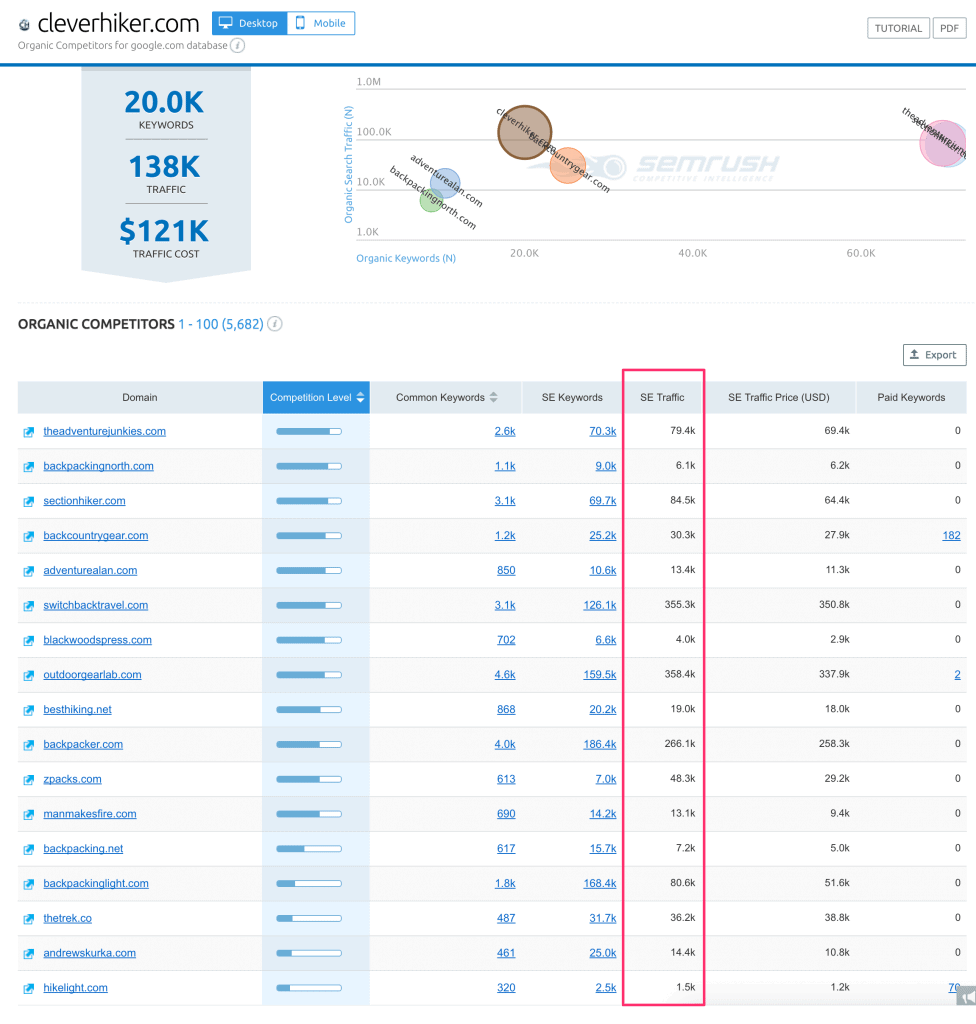
Here are a few big ones that I found.
Clever Hiker
Search engine traffic: 145.9k
Section Hiker
Search engine traffic: 85.8k
Note: Choose the sites you analyze according to what you plan to build yourself. For example, I’m ignoring ecommerce sites, simply because I don’t plan to get into ecommerce for this project. I’m choosing content sites because that’s probably the route I’ll be taking myself.
This is important to note as well: As I’m doing research in the hiking niche, I’ve found that a lot of the bigger sites are broader. They’re not just specific to hiking, but target all outdoor adventure. This is important to take note as I might decide to do the same if “Hiking” by itself is not a big enough niche to meet my goals with this project.
A few of these sites include:
Switchback Travel
Search engine traffic: 355.3k
Outdoor Gear Lab
Search engine traffic: 358.4k
Next, use SimilarWeb
SEMrush only gives you the search volume data, and not the overall traffic the site is getting.
It also filters by country and device. So in the screenshots above, that was for US search engine traffic on desktop only.
We need to use SimilarWeb to give more accurate overall traffic numbers.

So, let’s input the 2 big hiking sites we found in SEMrush into SimilarWeb.
Starting with Clever Hiker.
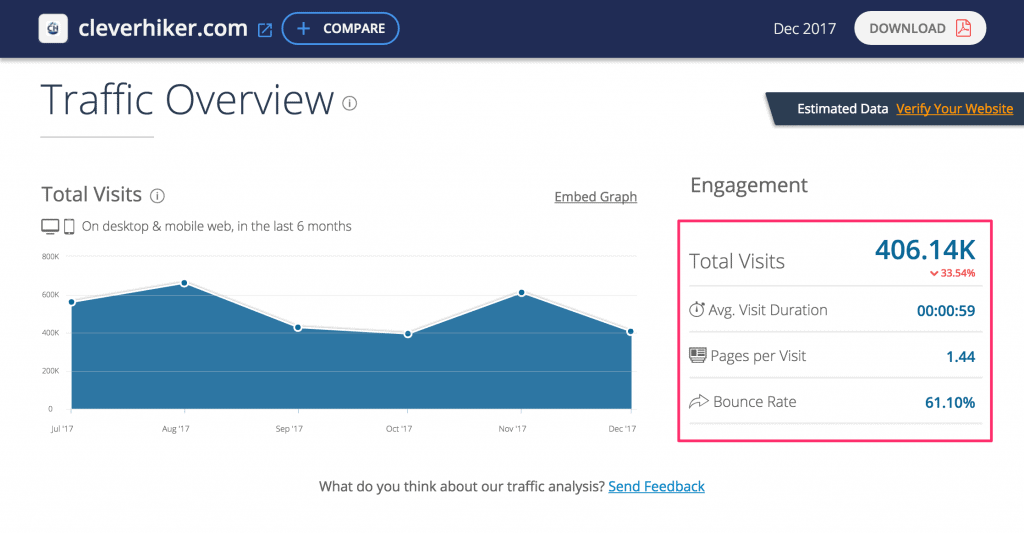
400,000 visitors per month is a good sign, but not great.
Remember this site is one of the biggest in the hiking niche. So for one of the top sites to be getting 400,000 means that growing to millions of uniques may not be a big possibility in this space. But we’re not completely sure yet. We’ll have a better idea when we look at other sites as well.
The next thing we need to check is traffic source. We need to make sure that that traffic is mainly coming from search.
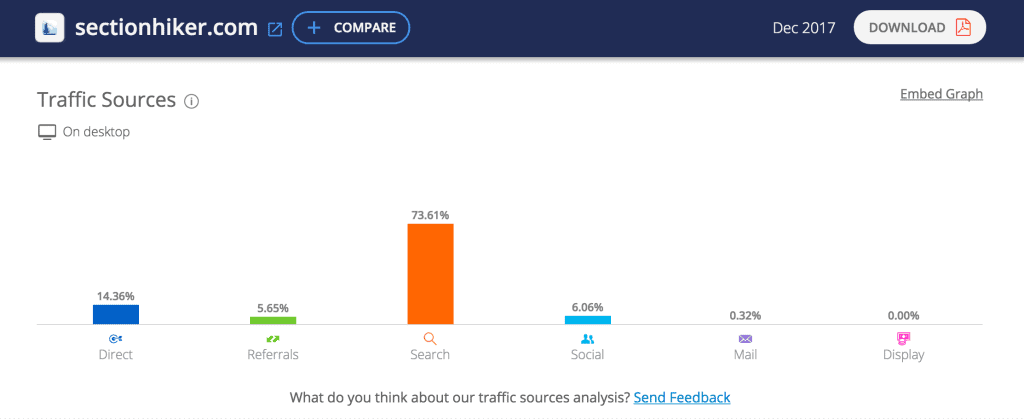
Good!
What we don’t want to see is a huge percentage of traffic coming from social. Again, this is because my own traffic strategy won’t involve much social media traffic, and will depend on search as well.
So now let’s look at the second site we listed: Section Hiker.
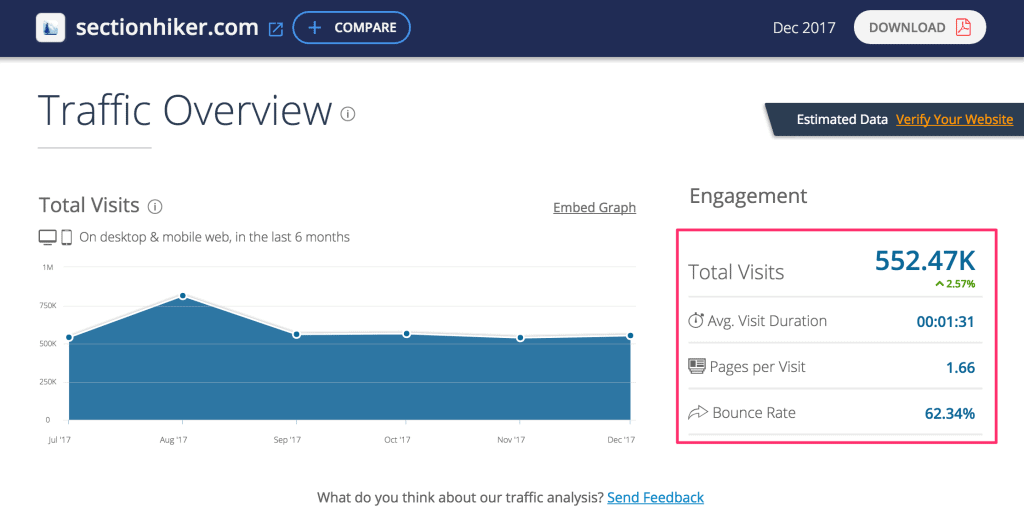
Another good sign at 500,000 visitors per month, and pretty consistent with the first site we saw.
And the traffic source is looking good too, with the majority of that traffic coming from search.
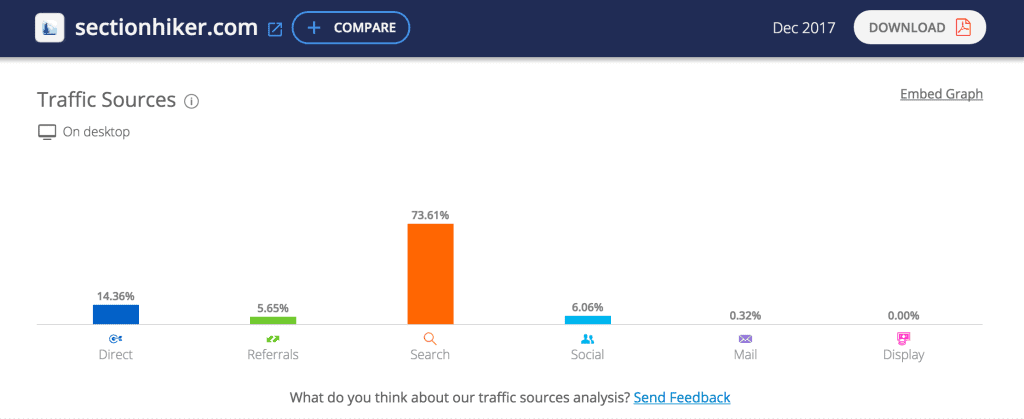
Analyze more sites
NOTE: Similar Web isn’t always 100% accurate. These two sites very well can be getting over a million uniques per month. So it’s important to analyze more sites. In our example, we only walked through 2 sites. You can (and should) analyze 5 to 10 competitors if you’re serious about entering the niche.
You can find more sites to analyze in SimilarWeb, too by scrolling to the bottom.
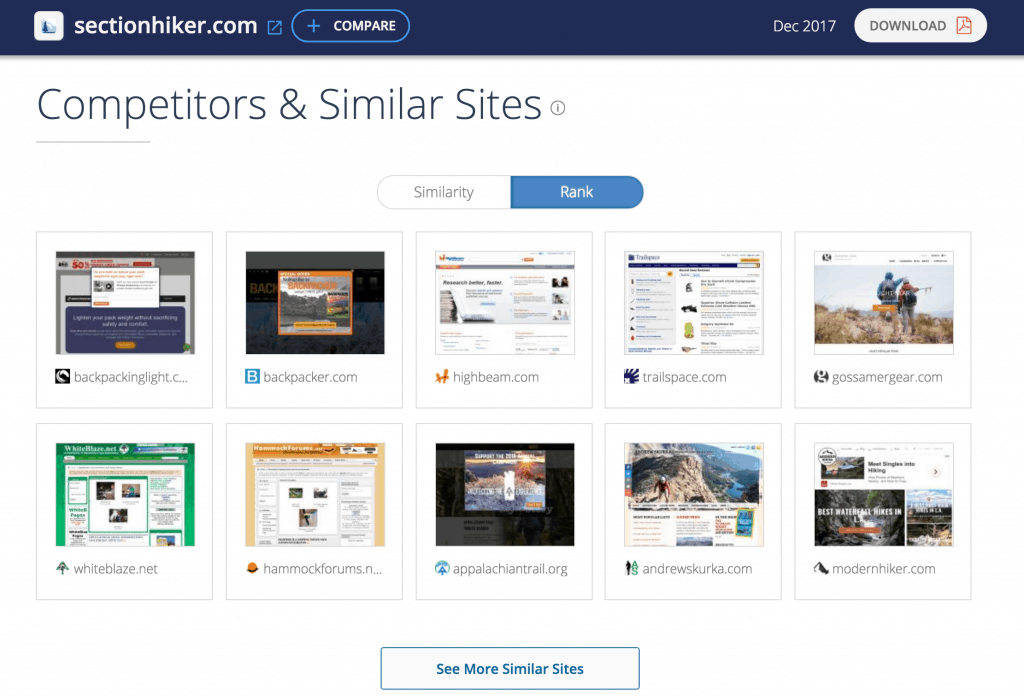
You can also just use Google and SimilarWeb if you don’t want to pay for a SEMrush subscription.
But if you do decide to enter any niche, it can be extremely helpful to have SEMrush, as you’ll be able to see exactly what keywords each competitor is ranking for.
Like this:
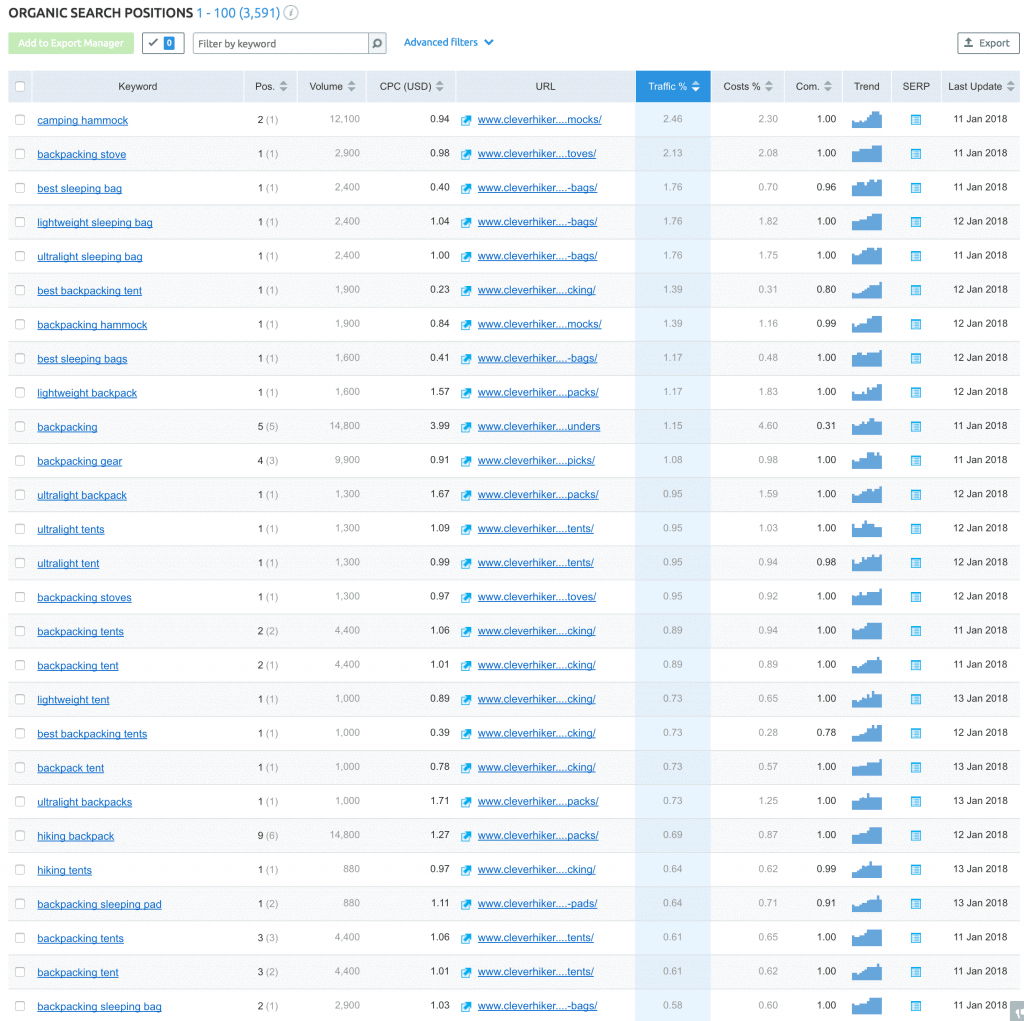
Next step: Analyze backlink data
The next step in the process is to analyze the backlink data of each site.
No need to get too deep in this section. We’re just trying to get a quick idea of how strong their backlink profiles are, compared to how much search traffic they’re pulling in.
To do this, I’ll just quickly run them through Moz and Ahrefs.
What I’m hoping I don’t see are huge domain authorities and hundreds of thousands of links.
Clever Hiker

Moz shows only 71 total links from 29 domains, and a domain authority of 32. Seems really low.
Let’s check Ahrefs.

2300 links from 379 domains. Makes more sense.
But nothing too crazy. I can definitely build a stronger link profile than this site.
Section Hiker

Moz shows that Section Hiker has a stronger link profile and better DA, but again… nothing too crazy.
Let’s check Ahrefs.

316,000 links from 2200 domains. Section Hiker is definitely a stronger site with more links, and it makes the next part make more sense.
Content Analysis
The next step is to analyze content. Ideally, I would like to see really thin, ugly, outdated articles on the site. That means that I can easily create something 10x better.
To do a quick analysis, I’ll open up BuzzSumo and check out their most shared content.
So let’s go through each site.
Section Hiker
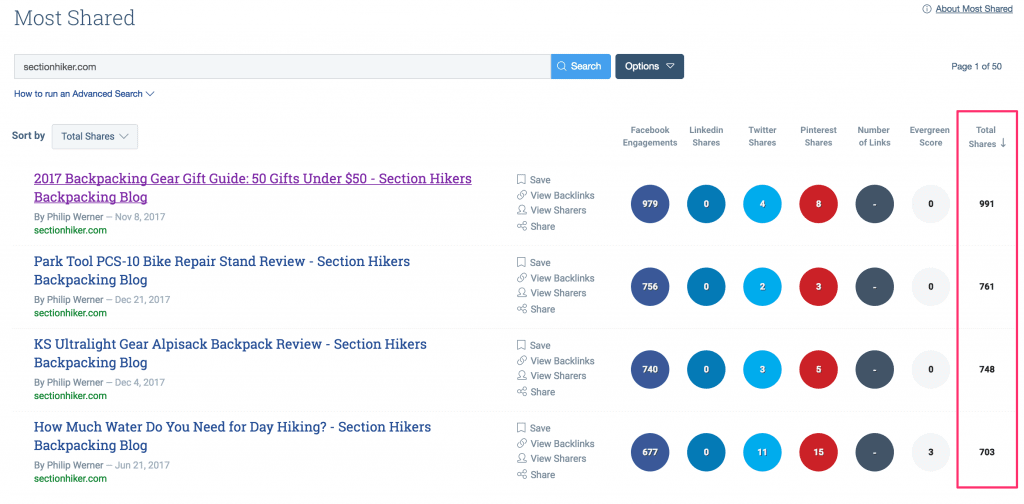
And if we take a look at the top most shared piece of content…
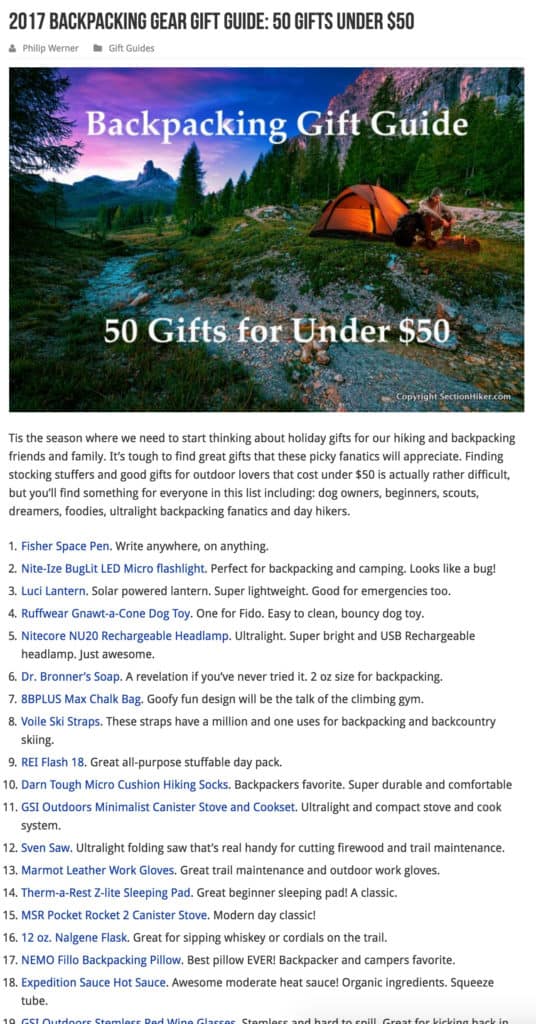
You’ll see that it’s very bare. It’s just a list with thin content. Descriptions are short, and there are no nice visuals on the page.
It can definitely be improved. Easily.
This is what we want to see.
Clever Hiker
Let’s take a look at Clever Hiker now.
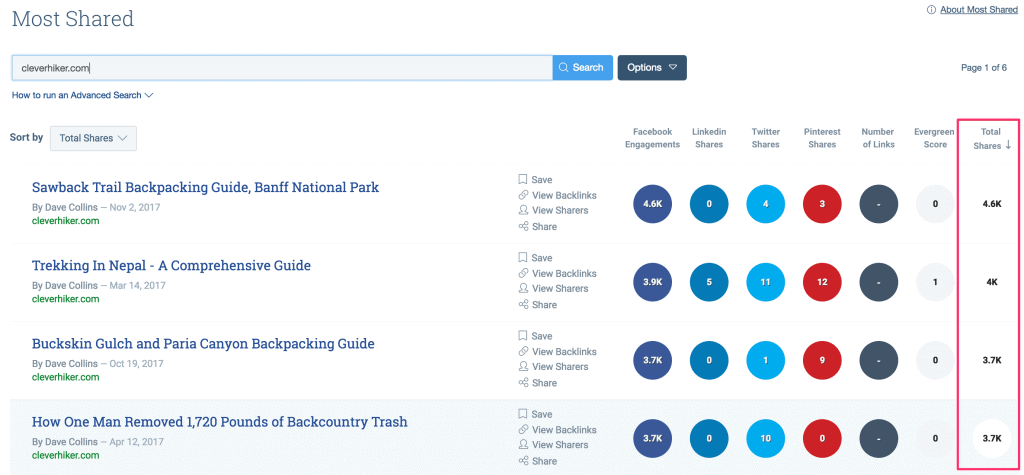
A lot more shares than Section Hiker. I’m also noticing that Facebook is the platform with the most activity in this niche. Good to know.
Let’s take a look at the content.
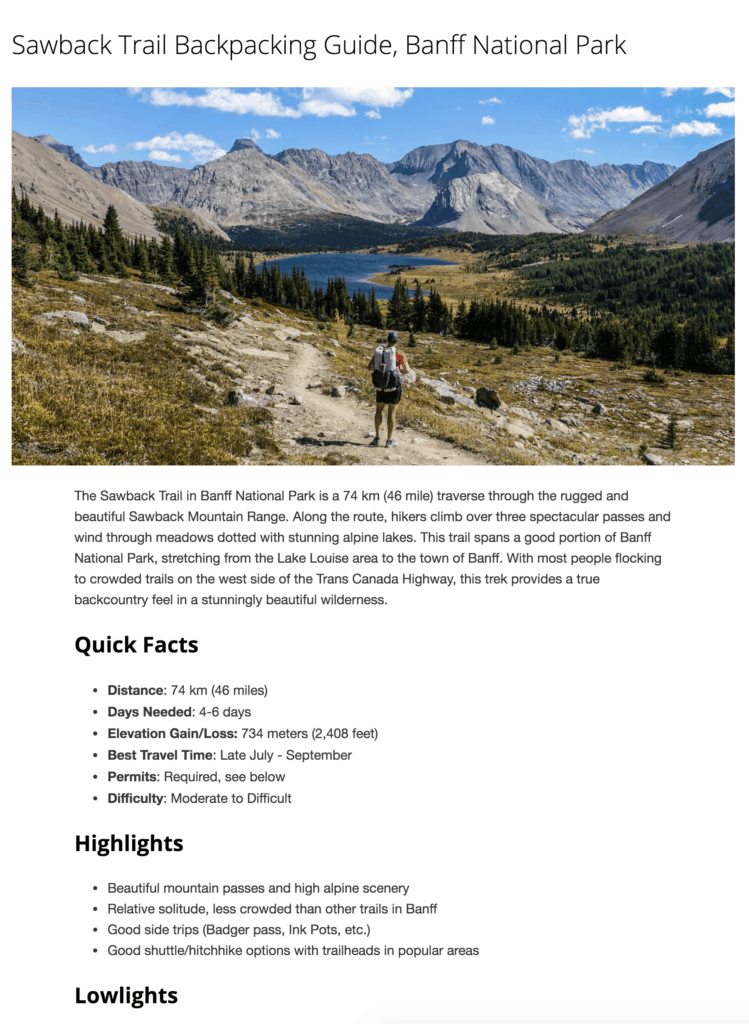
Their content is perfect, exactly the kind of content I would want to create myself. They have beautiful images (taken themselves it looks like) and they’ve organized the content perfectly with in-depth descriptions, and a lot of external links to helpful resources.
They’re a site I would want to model my own content after.
Thoughts on link profile and content
The link profiles make the content and traffic make more sense. Section Hiker’s content is on the thin side, especially when compared to Clever Hiker, but it’s pulling in more traffic because it has a much stronger link profile.
This is more or less a good sign for us. The site with strong content are not good link builders, and the site with good link building are not great content publishers. So there’s an opportunity there if we can create great content AND strong links.
Last step: Monetization Options
The last step isn’t crucial, but it’s important to have an idea of how the site is going to make money.
I’ll do this by checking how competitors are monetizing their sites. For the 2 sites that we looked at here, it looks like their sole monetization strategy is affiliate. They do best product reviews, and link out to the purchase links with an affiliate link. I don’t see any display ads, or sales pages for their own products.
Section Hiker doesn’t collect emails, but Clever Hiker does (but not aggressively). They also seem to only be sending out emails on a monthly basis.

It doesn’t seem like email is a big part of their growth or monetization strategy.
Monetization opportunities
One thing that I would do is be more aggressive with email collection, and engage the list on a weekly basis. That would help with both traffic, and in rolling out new monetization strategies in the future.
Although I feel that affiliate marketing should be the main monetization strategy, there are some other methods I can experiment with in the future.
1. I can sell info products (trail guides for the most popular hiking trails, or survival guides). They wouldn’t be huge products, most likely in the $20-$50 price range.
2. Physical products (things like a Hiking Kit, hat, shoes, etc). Of course, this would only be far into the future once I do build up good branding and a loyal audience.
3. Sponsored content. If the price is right, sponsored posts from outdoor brands could be pretty lucrative if I’m getting a lot of traffic.
But it seems pretty clear that affiliate marketing can be pretty profitable on its own for this particular niche.
Further analysis in the niche
One more step that you can do if you really want to go deep into the niche research process is to analyze smaller sites.
Look through SEMrush and find the smaller sites. Analyze their content, traffic, and backlinks.
Answer these questions:
1. How old are these sites?
2. Why are they not receiving as much traffic as the other ones?
3. How strong is their backlink profile and what kind of search traffic is that equating to?
4. How strong is their content?
5. Are any of these old, inactive sites that I could potentially make an offer for purchase?
Final thoughts about this niche: Does building a hiking site make sense?
So based on everything we looked at here, does a hiking site make sense? Would it be “enough” to make it worth the effort?
Yes, the niche looks pretty good if we’re looking only at the data we got from this analysis (that may change if we analyze more sites).
But… I wouldn’t target just hiking alone.
And here’s why…
The niche itself looks great. But I think there is more opportunity here. At this stage, I can only conclude that growing to millions of visitors per month with search traffic isn’t going to be very possible, unless I expand into other niches as well.
Hiking is very closely related to most other things that are outdoor adventure. This is truer here than it might be for other niches.
For example, if you’re starting an authority site about golf, it wouldn’t make sense to just target “outdoor sports” instead.
But hiking… if you’re hiking, you most likely love the outdoors. And that means niches like camping, kayaking, mountain climbing, etc are also viable niches to target under the same umbrella. That makes it much easier (and profitable) to expand and take advantage of your domain authority and power in the serps in the future.
If you remember, we did note that earlier…
A lot of the bigger sites that showed up in SEMrush had 3 to 5 times the traffic that these hiking sites were getting.
I’m not going to go through the entire process again here, but the next step would be to run this same analysis for those sites as well and compare it to hiking alone.
And then you may even want to go further and analyze each individual niche that they’re targeting.
Conclusion
Doing niche research properly and effectively is a lot of work. And depending on what you’re looking for, it can take a lot of time as well.
Hopefully this walkthrough has helped you better understand what exactly you should be thinking about, and looking for during each step of the way.
Originally, the plan was to analyze several niches in this blog post. But we’re already over 2,000 words in, and it seems like it would be overkill to go through everything two to three more times.
If you’re interested in more niche analysis articles, let me know in the comments. I’ll be happy to share some of the things I’m finding from my own research, and maybe do a few more of these posts where we analyze niches together 🙂